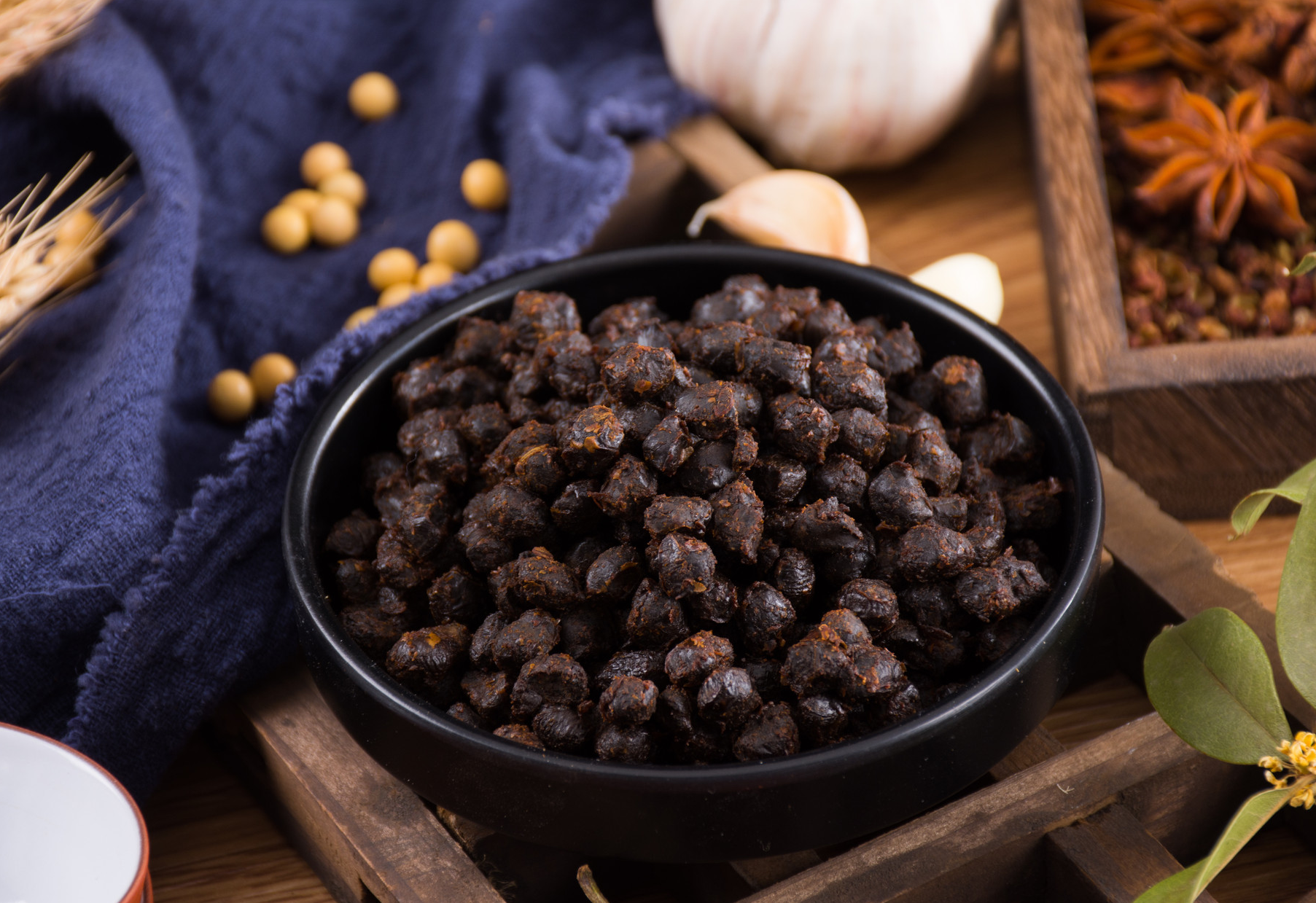Fermented beans Chinese(Douchi)
Douchi is a traditional Chinese fermented bean condiment, primarily made from yellow soybeans. It is created through fermentation using molds, such as Aspergillus, or bacterial proteases. Douchi is widely used in Chinese cuisine, and it is an ingredient in the famous Lao Gan Ma chili sauce.

 2 Comments
2 Comments
1.What is douchi?
Douchi is a traditional Chinese condiment made primarily from fermented yellow soybeans. The process of making douchi typically involves soaking, steaming, fermenting, and drying the beans. During fermentation, yellow soybeans interact with salt and other agents to develop douchi's distinctive flavor.
Douchi has a rich salty taste and unique aroma, making it a popular seasoning in various Chinese dishes. It is suitable for regional cuisines such as Sichuan, Hunan, and Cantonese, with common dishes including fish-flavored shredded pork, Kung Pao chicken, and twice-cooked pork. Additionally, douchi can be used for marinating meats, seafood, and vegetables to enhance their flavor.
Beyond China, douchi is also widely used in dishes from other Asian countries. It is a protein-rich food that contains a variety of vitamins and minerals, contributing positively to overall health.
2.The History of Douchi
Douchi has a long history in China, dating back to the pre-Qin period. It is mentioned in Liu Xi's "Explaining Names: Food and Drink" from the Han Dynasty. The "Book of Food" from the 2nd to 5th century also refers to the "method of making douchi," and ancient texts like the "Book of Han," "Records of the Grand Historian," "Essential Techniques for the People," and "Compendium of Materia Medica" contain descriptions of douchi. Originally, douchi emerged in Taihe County, Jiangxi, and later spread overseas. In Japan, it was referred to as "naji," and it is commonly consumed in various Southeast Asian countries.
In Chinese culinary culture, douchi serves not only as a seasoning but also has medicinal applications, highlighting its versatility and significance.
3.How to Make Douchi
Ingredients: Yellow soybeans, salt, chili powder, Sichuan pepper powder, ginger, garlic, and cooking wine.

Soak the Soybeans: Rinse the yellow soybeans and soak them in clean water for a while to allow them to fully absorb moisture and expand.
Steam or Boil the Soybeans: Place the soaked soybeans in a steamer or pot and cook until they become soft.
Ferment the Soybeans: Let the cooked soybeans cool, then transfer them to a container, sealing it with plastic wrap or cheesecloth. Place the container in a warm area to ferment for several days to a week, depending on the temperature and humidity.
Seasoning: Once fermented, remove the soybeans and mix in salt, chili powder, Sichuan pepper powder, ginger, garlic, and cooking wine. Stir well to combine.
Drying: Spread the seasoned soybeans out in sunlight to help evaporate moisture and enhance their aroma. Drying typically takes several days to a week, depending on weather conditions.
Storage: Store the dried douchi in a sealed container in a cool, dry place. While douchi can be preserved for a long time, it’s best consumed within a year.
4.What Does Douchi Taste Like?
Douchi has a firm and slightly chewy texture, with a mildly salty flavor and a unique aroma. When cooked, it releases a rich taste that adds distinct layers to dishes. It features a fermented tanginess and a bean-like fragrance, enhancing the overall flavor profile. Use douchi in moderation to avoid overpowering saltiness or altering the dish's overall taste.
5.How to Use Douchi
Douchi is a versatile ingredient with various uses, including:

Cooking Dishes: Douchi can be used in stir-fries, stews, and soups to enhance flavor and aroma. Many Sichuan dishes, like Mapo Tofu and Twice-Cooked Pork, incorporate douchi to elevate the overall taste, even if it’s not the main seasoning.
Making Sauces: Grind douchi into a powder or chop it finely to mix with other seasonings, creating douchi sauce or chili sauce, perfect for tossing with noodles, rice, or as a dipping sauce.
Marinating Ingredients: Combine douchi with salt, sugar, and cooking wine to marinate meats and fish, enhancing their flavor.
Steaming Foods: Place douchi on top of ingredients like steamed fish or pork ribs, allowing the food to absorb its aromatic qualities during cooking.
Cold Dishes: Chop or grind douchi to add to cold dishes, boosting their flavor profile.
Hot Pot Seasoning: Adding douchi to hot pot broth enhances its aromatic richness.
6.Where to Find Douchi
Local Chinese Supermarkets: This is the most common and convenient option. Many large cities with Chinese communities have Chinese supermarkets that typically stock a variety of products from China, including douchi. For example, in cities like Los Angeles and New York in the U.S., Vancouver and Toronto in Canada, and London in the UK, you can usually find different brands and types of douchi, including dried and wet varieties.
Asian Supermarkets: Some large Asian supermarkets may also carry douchi. These stores offer a wide range of products from various Asian countries. In addition to Chinese douchi, you might find similar fermented bean products from Japan and Korea, though the selection may be more limited.
Online Shopping Platforms: Well-known e-commerce sites like Amazon often have douchi available. Some online stores specializing in Asian foods also offer douchi. Shopping online provides access to a broader range of brands and products, with the convenience of home delivery, though you should consider shipping times and costs.
Making It Yourself (If Possible): If you have the time and resources, you can try making douchi at home. Purchase soybeans or black beans and follow traditional methods for fermentation and production. However, this requires some experience and skill, so searching for relevant recipes online can be helpful if you decide to give it a try.
7.How to Store Douchi
To store douchi, place it in a sealed container and keep it in a cool, well-ventilated area. It can be preserved for a few weeks to a couple of months this way. Alternatively, you can refrigerate it, which can extend its shelf life to several months or even up to half a year. Douchi can also be frozen, although this may affect its texture and flavor. Another method is to soak it in cooking oil before sealing it in a container, which can similarly extend its freshness for several months.
When storing douchi, make sure to use fresh, uncontaminated beans, and always use a clean container. If you notice any signs of spoilage, discard the douchi immediately.
8.Recipe for Douchi Pork Ribs
Douchi pairs well with various ingredients, including ribs, pumpkin, and chili. Today, we'll be making a traditional Chinese dish: Douchi Pork Ribs. This dish features the rich flavors of douchi combined with tender pork ribs.
To start, marinate the pork ribs with seasonings to enhance their flavor. (Below is a detailed step-by-step guide with pictures for making Douchi Pork Ribs.)
9.More Delicious Recipe Recommendations
Here’s the detailed tutorial for making Douchi Ribs—let’s get cooking together! If you enjoy our recipes, please follow our official email for ongoing updates and more quality content!
INGREDIENTS
MAIN INGREDIENTS
- 500g ribs
- 10g fermented black beans (douchi)
ACCESSORIES
- 1 potato
- A few small chili peppers
- 2 green onions
- 1 clove garlic
- 2 slices ginger
SEASONINGS
- 2 tablespoons cooking oil
- 0.5g salt
- 1 tablespoon cooking wine
- 1/2 teaspoon pepper
- 2 teaspoons cornstarch
- 1 tablespoon soy sauce
DIRECTIONS
STEP 1
Prepare all the ingredients. Cut 500g of pork ribs into pieces and wash them.

STEP 2
Place the ribs in a bowl, then add 2 tablespoons of cooking oil, 2 teaspoons of cornstarch, 0.5g of salt, 10g of fermented black beans, 2 slices of ginger, sliced garlic, and 1 tablespoon of soy sauce.

STEP 3
Add 1 tablespoon of cooking wine.

STEP 4
Mix well and let it marinate for 20 minutes.

STEP 5
Peel and wash 1 potato, then cut it into small pieces.

STEP 6
Toss the potato pieces with a pinch of salt and pepper, then spread them evenly on a plate.

STEP 7
Lay the marinated ribs on top of the potato pieces, pouring the marinade over them.

STEP 8
Place the ribs in a steam oven and steam at 100°C (212°F) for 30 minutes.

STEP 9
After 30 minutes, remove the ribs and sprinkle with chopped chili peppers and green onions.

STEP 10
Enjoy your delicious fermented black bean ribs!

Frequently Asked Questions:
1.Are Chinese fermented black beans good for you?
Chinese fermented black beans, or douchi, can be beneficial in moderation. They are rich in protein, have antioxidant properties, and aid digestion. However, due to their high sodium content, those monitoring their sodium intake should consume them sparingly. Overall, douchi can add flavor and nutrition to a balanced diet.
2.What does douchi taste like?
Douchi has a unique flavor profile—salty, savory, slightly bitter, and a hint of sweetness. The fermentation process gives it a rich umami taste, often described as earthy and pungent. Some may also notice a subtle smoky aroma. When cooked, douchi enhances the overall flavor of dishes, making it a popular ingredient in Chinese cuisine.
3.How to use Chinese fermented black beans?
Douchi is versatile and can add depth to many dishes. Common uses include:
Stir-fries: Finely chop or mash and add to stir-fried vegetables, meats, or seafood with garlic and ginger.
Sauces and marinades: Mix with soy sauce and garlic for a flavorful marinade for meat, poultry, or tofu.
Steamed dishes: Sprinkle on steamed fish or vegetables before serving to release their flavor.
Soups and stews: Add a small amount to enhance the flavor of soups or stews, especially with pork or mushrooms.
Fried rice: Incorporate into fried rice for an extra layer of savory flavor.
Start with a small amount and rinse the beans to remove excess salt and impurities.
4.What are fermented beans called?
Fermented black beans are known as "douchi" in Chinese cuisine. These small black soybeans are fermented and preserved in salt, giving them a distinctive savory flavor. They are also used in other Asian cuisines—called "chunjang" in Korean and "dajiang" in Japanese.
Recipe analyzer
- Recipes: Fermented beans Chinese(Douchi)
- Main Ingredients:7
- Servings per recipe:1
- Servings size:899 g
-
Energy (calories):1969 kcal
-
Protein:91.54 g
-
Fat:146.33 g
Why gray?

-
Carbohydrates:66.67 g
-
Protein: 19%379 kcal
-
Fat: 67%1320 kcal
-
Carbohydrates: 14%268 kcal

The ratio shows whether the proportion of both fatty acids in your diet is optimal. Red color means too much of Omega 6 or too little of Omega 3. The data are rounded off and approximate.









2 REVIEWS